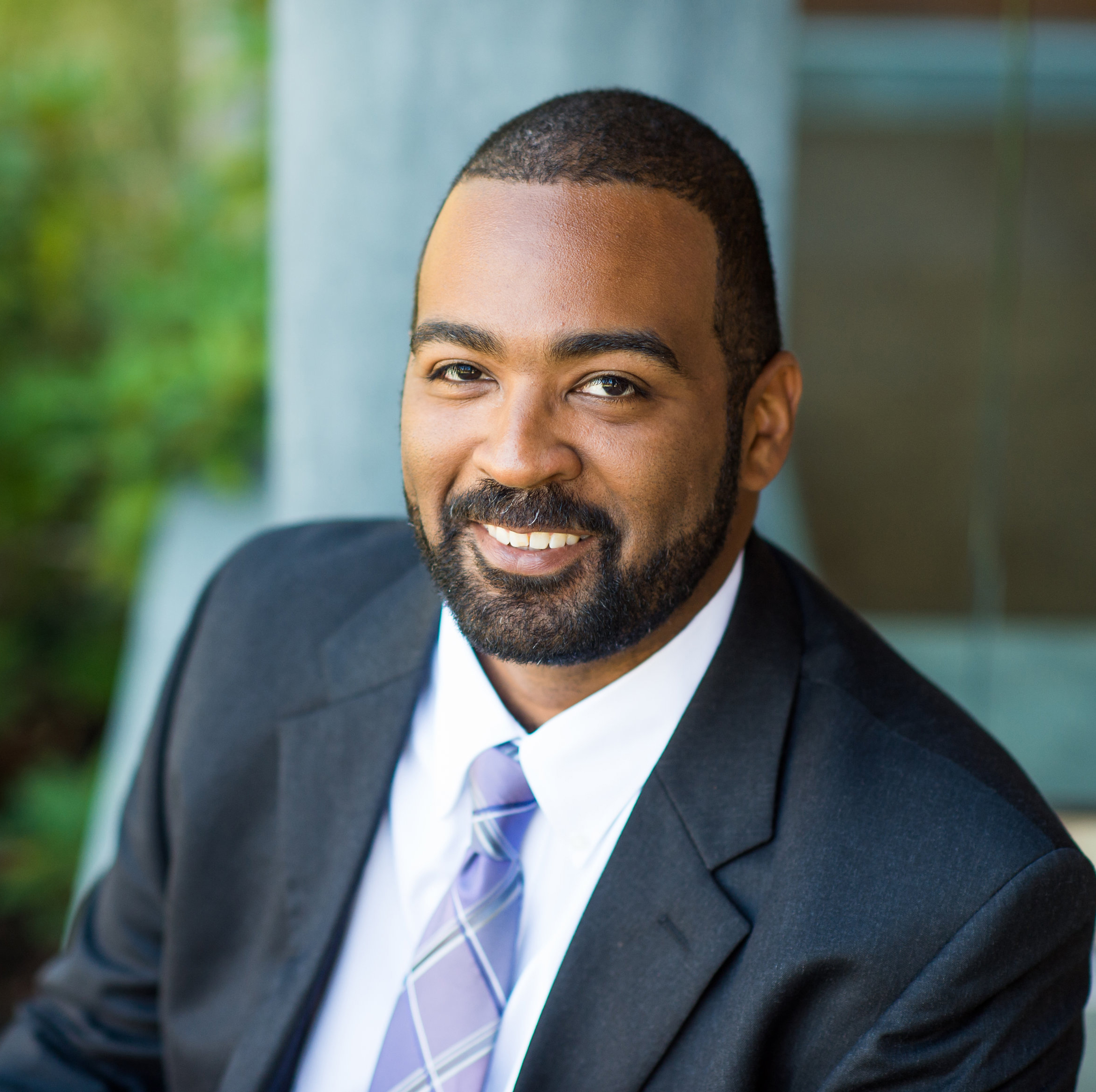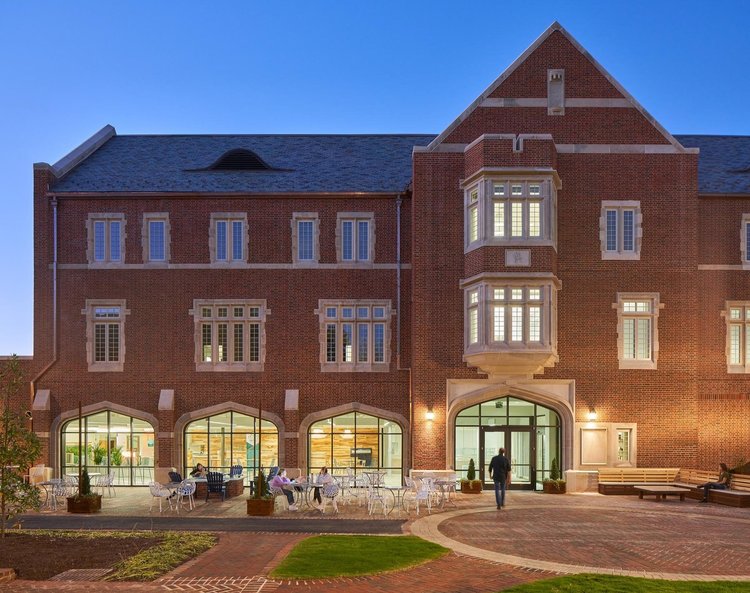
Sidney Griffin, AIA, NOMA, chooses his words carefully, with a calm reassuring voice like the countdown to a shuttle launch — perfect for navigating frustrated colleagues through a difficult computer crash or corrupted BIM model. On a sunny February afternoon, I met with Griffin to discuss his new role as the first BIM Project Manager for the University of Virginia’s Geospatial Engineering Services, the future of integrating technology and buildings to benefit building owners, and how serving our clients better and becoming a more inclusive profession could go hand in hand.
Technology support is so vital to our productivity that we’re often blind to its value — only noticing when something goes wrong. Like water or electricity, we expect technology to work every time, and rarely consider the thousands of hours of unseen work that makes it possible, or that our colleagues in tech support can’t quit until the problem’s solved and the team can get back to work.
After 20 years as BIM Manager and Director of Digital Design at VMDO, Griffin is exceptionally talented at managing crisis and planning for the best use of the right tools. He knows better than most what’s required for design firms to do great work, and the toll it can take on staff. “When your computer shuts down, model crashes, headphones or camera don’t work, or the conference room’s a mess, someone solves these problems for you — and the best leaders understand that ‘many hands make light work’.”
“If you don’t celebrate people and give them a reason to feel proud about their work, you’ll lose them.”
While our profession often promotes talented designers skilled at public speaking and winning work, for Griffin, “much of the work in an office is a hamster-wheel that supports the glamorous side of architecture” which he describes as “shaking hands with the owner, presenting work that’s been done for you, and accepting awards — while that background work goes unrecognized.” This can “feel like being overlooked, it sours relationships, and breeds resentment,” especially for those in roles that serve multiple teams, governed by constant deadlines, interruptions, and scheduling challenges that can contribute to burnout. As pandemic restrictions ease and many employees seek out new prospects, Griffin warns, “If you don’t celebrate people and give them a reason to feel proud about their work, you’ll lose them.”
Losing Cornerstone employees who are self-motivated, driven, dependable team players that help multiple teams do great work, is a challenge for any organization. According to Griffin, addressing this could require changes like “providing more transparency about staffing to let people know what’s coming down the pike and give them a chance to choose the work they want to do.” This can be difficult for even the best firms because it “requires being open to changing your plans to support their needs, and I don’t see that happening — the business of architecture takes precedence.”
“The possibilities for integration are endless”
Griffin’s decades of experience and love for solving complicated puzzles prepared him for his new role supporting UVA’s mission as an organization-wide resource. His focus is “building a plan to manage all the University’s BIM models, helping departments across the University get up to speed on how to pull data from their models for use in business planning and building operations, preparing models to receive data from sensors in buildings, and creating a digital twin of the Grounds for maintenance and systems control.” Exploring how BIM integration can serve client’s needs “is what excites me about this job, and the possibilities for integration are endless.”
Working on the client side has helped Griffin see that for many clients, “cost is the bottom line, and the function of the space is more important than what architects think of as design.” While some clients want signature buildings, most have less ambitious needs. “We give ourselves a gauntlet to run through, reward ourselves with pats on the back or slaps on the wrist, but the owner doesn’t care,” especially if they’re “basing their expectations on what they already have that works, then they think the project is just ‘copy-paste,’ and they undervalue what architects do.” When project goals for architects and clients are not aligned, Griffin suggests we “step back, apologize, and ask our client what they need” to build trust, establish a baseline, and help guide them to the best possible solution. After all, Griffin believes “the building we’re designing is theirs, and we should strive to solve their problem first and be of service, instead of focusing on how it will look or the possibility for awards.”
Griffin’s first break at VMDO Architects was Kenmore Middle School. As the only team member, Griffin was able to manage the project the way he preferred. By “meeting the client where they were,” he prioritized the client’s limited budget and significant needs to deliver the design on-time and on budget. “After that VMDO saw me as more than a BIM operator, and I got a lot of recognition.” As a prized utility player, he was tasked with documenting complicated projects, like custom limestone detailing at the University of Richmond that helped connect the new building to the fabric of the existing historic campus. With no precedent for doing this in Revit, he created new ways to “break it down into pieces so what you see in the elevations and details is what’s in the model — don’t shortcut anything, do it right.”

Though it’s outside his comfort zone, Griffin took a leadership role in the AIA “because I have a perspective other Board members do not, I can be a voice for those who don’t have a voice yet.” As the profession, AIA, and NOMA move to address the challenges many women, people of color, and first-generation students face, Griffin acknowledges there is still much to do. “Architecture has very low percentages of people of color, specifically Black people — 5% less than any other industry, and Black women even less. I’m one of only 2,500 Black architects in the US — that’s a travesty.”
For Griffin, the challenge architecture faces to build an inclusive profession starts in school, where he recalls struggling to balance working to pay his expenses and frustrating his professors. “They’d assign a project for the next day and then ask, ‘Why didn’t you finish?’ All I could say is ‘I had to work last night to afford this $100 model’.” But this creates an imbalance, “when your classmates can easily afford more it sets a high bar, and if you have to point that out, you’re making clear that this is not a safe place for you.” When I asked what black architects he looked up to when he was in school, after a long pause he replied, “I don’t know, there weren’t any. How can that be?” Experiences like this made architecture school feel “elite, foreign, and expensive, where you either play by the rules or you’re on the outside.”
“When people get excited about your work, it’s because it reflects them and their culture.”
Griffin’s approach to designing public spaces, especially schools, as nurturing environments for all students was inspired by imagining “what a student needs to see, touch, or smell to feel like they’re in a safe place.” Drawing inspiration from exclusion is important because “most people in our profession have never been the only person in a room who looks like them. For some people, school is the safest place they have.” He continued, “post George Floyd, I hope architecture curriculum can recognize that we don’t come from the same place. We need to meet students where they are instead of asking them to fit a mold they’re not prepared for.” He’s concerned that architecture school “ignores the history students bring with them: what’s their culture, where are they from, what kind of upbringing did they have?” and believes these unique perspectives should be seen as qualifications, not something to ignore or unlearn. “Architects should understand that what we offer our clients is not our work, it’s who we are, that’s what allows us to help, or say, ‘I understand your pain points, your experience, and here’s what I recommend’.” Griffin hopes that schools and firms will embrace culture “as a tool that can help designers solve problems — you might be struggling to find the best solution because you’re not from that culture.” In his experience, “When people get excited about your work, it’s because it reflects them and their culture.”
Because his new job is less deadline-driven, Griffin’s been thinking about the architecture profession’s problem with time. “Architecture is one of the only professions where you’re taught in school to overwork, to value the work over your time. When you move to an office it continues, we make the studio comfortable with music, drinks, and socializing, but you’re there at the expense of something else.” His kids have noticed a change, “my daughter said, ‘We see you more than we ever have before,’ and it feels good, like I made the right choice.” He wonders why architects are less involved in fun activities that can also benefit their careers? “My mom told me to learn golf, ‘Business happens on the golf course, not in the board room.’ I never learned, but maybe I should have — I could’ve ended up on the glamorous side!”
“What we offer our clients is not our work, it’s who we are, that’s what allows us to help”
As our conversation wound down, Griffin wondered aloud if architects can feel ennobled by serving clients the way he thinks we should, with respect and love for who they are, “not using them to get where you want to be, but to meet them where they are, help them get where they’re going, and then stop. ‘We have the love to get you where you want to be’ — I’d work in a firm that has that motto.”
– SHAWN MULLIGAN, AIA, NCARB
About the Cornerstones series
The industry gives many awards for beautiful design, but rarely celebrates the individuals who serve in quieter, less public roles — the unsung heroes who make it possible to do great work. Like a cornerstone, they’re the foundation of our success, and we hope to share their stories, celebrate their victories, and gain a deeper appreciation for the many hands that make good design possible.
Cornerstones is a series created by AIA Central Virginia and republished with permission from the author.
